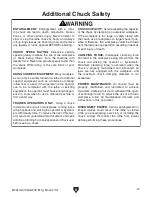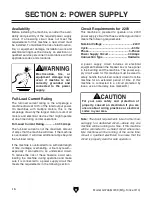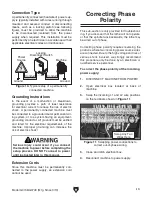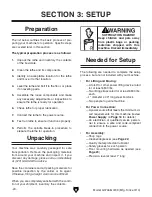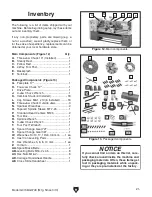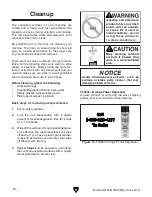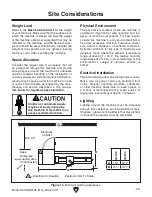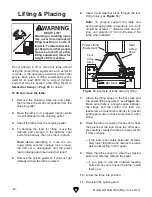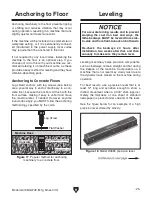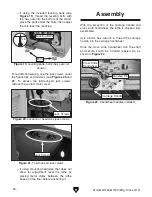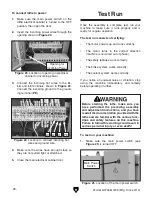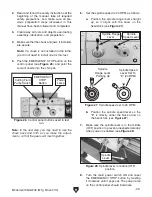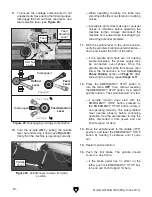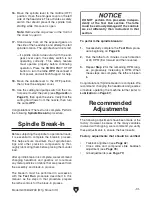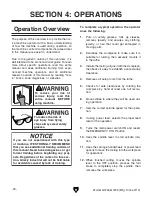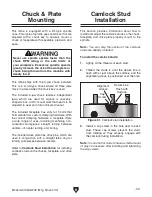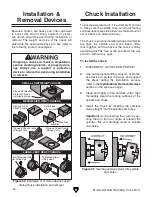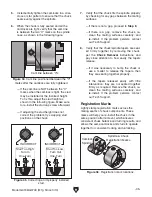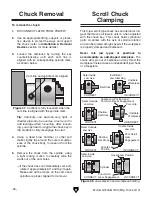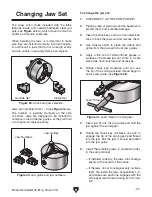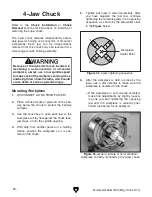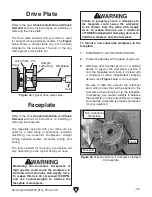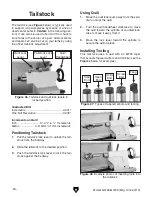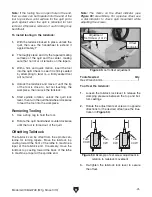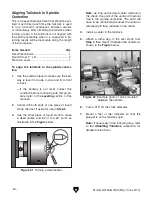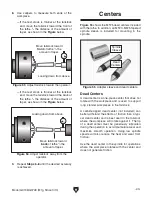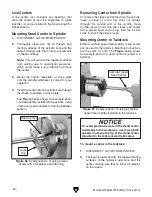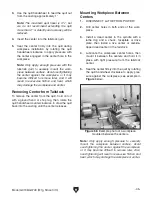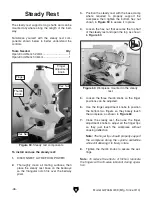
Model G0746/G0749 (Mfg. Since 3/13)
-31-
16. Move the spindle lever to the middle (oFF)
position. open the end-gear cover on the left
side of the headstock. this activates a safety
switch that should prevent the spindle from
starting while this cover is open.
Note: Remove the cap screw on the front of
the cover to open it.
17. stand away from all the exposed gears on
the side of the headstock, and attempt to start
spindle rotation. the spindle should not start.
— if spindle rotation does start with the end-
gear cover open, the safety switch is not
operating correctly. this safety feature
must operate properly before continuing
operation. press the EMErgENCy stop
button to turn the lathe
OFF, disconnect it
from power, and call tech support for help.
18. Move the spindle lever to the oFF position,
then close the end-gear cover.
19. Use the cutting fluid pump switch on the con-
trol panel to start the pump (see
figure 26 on
page 29), then open the valve. Verify that the
cutting fluid flows from the nozzle, then turn
the pump
OFF.
Congratulations! the test run is complete. perform
the following
Spindle break-in procedure.
To perform the spindle break-in:
1. successfully complete the Test Run proce-
dure beginning on
page 28.
2. run the lathe for 5 minutes in each direction
at 24 rpM (first forward and then reverse).
3. repeat Step 2 for the remaining rpM rang-
es, progressively increasing in rpM. When
these steps are complete, the lathe is broken
in.
Congratulations! spindle break-in is complete. We
recommend changing the headstock and gearbox
oil before operating the machine further (refer to
Lubrication on page 67).
the following adjustments have been made at the
factory. however, because of the many variables
involved with shipping, we recommend you verify
these adjustments to ensure the best results:
factory adjustments that should be verified:
•
tailstock alignment (see
page 42).
•
Cross slide and compound slide backlash
adjustment (see
page 78).
•
gib adjustments
(see
page 79).
Recommended
Adjustments
Spindle break-in
Before subjecting the spindle to operational loads,
it is essential to complete the break-in process.
this helps ensure maximum life of spindle bear-
ings and other precision components by thor-
oughly lubricating them before placing them under
load.
after spindle break-in is complete, we recommend
changing headstock and gearbox oil to remove
any metal particles or debris that are present from
the assembly and break-in process.
the break-in must be performed in succession
with the
Test Run procedure described in this
manual, as the steps in that procedure prepare
the lathe controls for the break-in process.
DO NOT perform this procedure indepen-
dently of the Test Run section. The lathe
could be seriously damaged if the controls
are set differently than instructed in that
section.
Before subjecting the spindle to operational loads,
it is essential to complete the break-in process.
this helps ensure maximum life of spindle bear-
ings and other precision components by thor-
oughly lubricating them before placing them under
load.
after spindle break-in is complete, we recommend
changing headstock and gearbox oil to remove
any metal particles or debris that are present from
the assembly and break-in process.
the break-in must be performed in succession
with the
Test Run procedure described in this
manual, as the steps in that procedure prepare
the lathe controls for the break-in process.
DO NOT perform this procedure indepen-
dently of the Test Run section. The lathe
could be seriously damaged if the controls
are set differently than instructed in that
section.

